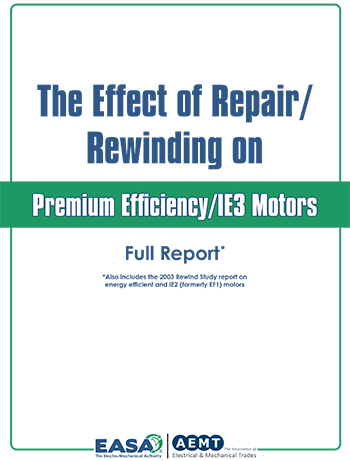This valuable publication explains the findings of a major study that analyzed the impact of repair/rewinding on the energy efficiency of Premium Efficiency/IE3 electric motors. This study was a follow up to a 2003 study.
The 2019 study reaffirms the results of the 2003 study.
 Abstract
Abstract
In response to various opinions about the feasibility of maintaining motor efficiency during repair, including replacement of the stator winding, the Electrical Apparatus Service Association (EASA) and the Association of Electrical and Mechanical Trades (AEMT) conducted two comprehensive rewind studies using third-party testing laboratories.
The results of the first study, which were published in 2003 (see Part 2 on Page 2-1 of this document), clearly showed that the efficiency of energy efficient and IE2 motors ranging from 7.5 hp to 200 hp (5.5 kW to 150 kW) can be maintained (and sometimes improved) if the stator is rewound using established good practice procedures.
The increasing use of premium efficient motors mandated by various countries led to a second rewind study in 2019, this time to determine if the efficiency of premium efficiency and IE3 motors can be maintained when they are rewound using the good practices described in the 2003 rewind study and ANSI/EASA AR100-2015: Recommended Practice for the Repair of Electrical Apparatus.
As with the 2003 study, the results of the 2019 rewind study that follow clearly show the answer is YES–with the average efficiency change for the entire test group falling within the range of accuracy for the test method (± 0.2%). In several instances, motor efficiency actually improved.
Overview of the Table of Contents
- Part 1: 2019 Rewind Study–The Effect of Repair/Rewinding on Premium Efficiency/IE3 Motors
- Objective
- Products evaluated
- Standards for evaluating losses
- Third-party testing protocol
- Results of efficiency tests on rewound motors
- Conclusion
- Part 2: 2003 Rewind Study – The Effect of Repair/Rewinding on Motor Efficiency
- Objectives
- Products evaluated
- Standards for evaluating losses
- Third-party testing protocol
- IEEE Std. 12B test method: Input - output with loss segregation
- Core loss testing
- Results of efficiency tests on rewound motors
- Significance of test results
- Conclusion
BUY A COPY
Related Resources
-
Good Practice Guide to Maintain Motor Efficiency
Friday, January 15, 2021Intended primarily for service center personnel, the guide which is now an independent document and not part of the complete EASA/AEMT rewind study report, outlines the good practice repair methods used to achieve the results given in both studies. It contains repair tips, relevant motor terminology, and information about sources of losses in induction motors that affect efficiency.
-
Rewind Study 2020: The Results Are In
Wednesday, December 16, 2020This webinar covers the results and the technical details of the recently completed follow-up to the 2003 EASA/AEMT Rewind Study.
-
ANSI/EASA Standard AR100-2020: Recommended Practice for the Repair of Rotating Electrical Apparatus
Tuesday, September 1, 2020ANSI/EASA AR100 is a must-have guide to the repair of rotating electrical machines. Its purpose is to establish recommended practices in each step of the rotating electrical apparatus rewinding and rebuilding processes.
ANSI/EASA AR100
More information on this topic can be found in ANSI/EASA AR100
Print
